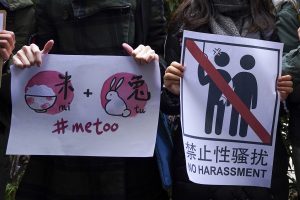On August 10, a Beijing court rejected the appeal of Zhou Xiaoxuan, who had accused a star presenter for state television of sexual harassment. The case was considered a landmark for the #MeToo movement in China because it galvanized other women to share their own stories of sexual harassment publicly. The impact was not only online, but it also triggered offline collective activities. For Zhou’s first trial in 2021, dozens of women gathered outside the courthouse to show their support, and the police did not intervene.
However, at the same time, discussion of the case was censored on social media, and only a few media outlets were allowed to provide a short story in line with the official line about the case, which demonstrates the growing anxiety over activism around women’s rights.
The #MeToo movement, in China and elsewhere, has been primarily digital, relying on the internet and social media as platforms and tools for mobilization, making alternative voices heard, and promoting awareness and civic engagement. One of the lasting effects of #MeToo in China, then, has been the ongoing social discussion regarding how to define sexual harassment. Since the public debate about sexual harassment has tended to cover a wide range of perceptions and personal experiences, legal terms and arguments serve as a valuable reference for what, precisely, the concerns are of those participating in it.
While “sexual harassment” is mentioned in the Law for the Protection of Women’s Rights and Interests of the People’s Republic of China (hereafter the Women’s Protection Law) that took effect in 2005, the statute did not define the term clearly. Among the more than 50 million publicly available court verdicts from 2010 to 2017, only 34 focused on sexual harassment, of which only two were brought by victims suing their alleged harassers – and both of these cases were dismissed owing to lack of evidence. Local anti-harassment regulations have also been enacted but have not been consistently enforced and implemented.
It was not until the end of 2018 that the Supreme People’s Court in China listed sexual harassment as grounds for civil lawsuits. On July 13, 2019, the first such civil lawsuit ended in a partial victory for the plaintiff. This outcome is considered groundbreaking in setting the tone for similar upcoming civil cases.
In 2020, a new Civil Code declared, “Party and government departments, enterprises, schools, and other institutions shall adopt appropriate measures to prevent and stop sexual harassment behaviors that take advantage of power or positions.” And during its public consultation period at the end of 2021, the draft of the Women’s Protection Law Amendment defined specific behaviors and expressions as sexual harassment and added requirements for schools to establish mechanisms to prevent and stop sexual harassment and assault.
Yet these improvements in the policymaking process and legal procedures have come at the cost of silencing grassroots activists working on the same issue. While some #MeToo allegations since 2018 have been slowly making their way through the judicial system, none has had any substantial results. Media and public interest in the cases have proved fleeting, partly due to the state-led media efforts to silence discussions.
In higher education, for example, no university has established or implemented any system for combating harassment, despite promises made in response to social pressure at the height of the 2018 #MeToo allegations, many of which involved students accusing their professors of sexual harassment. The new Civil Code that went into force in 2020 has been similarly ineffective in pushing universities to take proactive steps. This is because the central authority that deals with sexual harassment cases in most universities is the Disciplinary Board, a common administrative unit in government bodies and public institutions as an extension of the Party’s Central Commission for Discipline Inspection. Most of the cases have been approached from the perspective of the morality of the behavior of the accused faculty or staff member, and the punishment has usually involved administrative penalties and disciplinary sanctions, such as warnings, records of demerit, expulsion from the party, revocation of teaching qualifications and titles, and demotion.
Chinese authorities and powerful (male) players are resilient in exploiting the same digital affordances that powered #MeToo to counter the negative impact of online allegations, essentially drowning out victims of sexual violence. Returning again to the example of higher education, our study has demonstrated that, while digital media lowered the barriers to collective action for a variety of causes, grassroots activism must negotiate with various state institutions and system insiders to move forward with anti-sexual harassment campaigns. For example, a Chinese university can leverage its resources and power to influence social media content. While news media, especially state media, can bypass the universities and cover sexual scandals associated with them, their respective administrative rankings impact the outcome. In addition, offline collective activities would be suppressed even more quickly to prevent forming a movement.
The shrinking digital space for combating sexual harassment in China also reflects the increasing hostility of digital culture toward victims and the expanding misogynistic manosphere. Even when, or especially when, opposition to sexual harassment becomes a hegemonic discourse, the victim-shaming, witch-hunting, trolling, and doxing of victims and activists are prevalent. “Gender antagonism,” a new term used by many to describe the aggregated tension associated with public discussions of gender issues, includes heated debates between anti-sexual harassment activists and those who find fault with the victims. Lingering disputes proceeding from the question “Is this sexual harassment?” demonstrate the difficulty of establishing a lexicon for a perennial social problem and the dearth of enforcement mechanisms and systemic structures for countering sexual harassment despite recognizing it and repeated efforts to prevent it.
Zhou Xiaoxuan’s court case demonstrates the difficulties involved in fighting sexual harassment through legal channels, but also the barriers to advocate social change through a social movement. Any form of activism, whether online or offline, has little room to grow or expand under the tightened grip of government power.

































